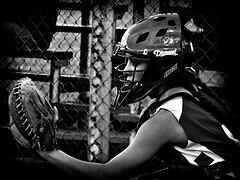Bottom of the fifth, Runner on First Base, One out. A brief glance of nervousness is exchanged as the runner on first receives the steal sign from her coach at third.
Bottom of the fifth, runner on first base. One out. A brief glance of nervousness is exchanged as the runner on first receives the steal sign from her coach at third. Her shoulders tense up as she refastens her batting gloves and arranges her feet on the base.

I slowly squat into position behind the plate and slide my sweaty facemask into place. With a deep, refreshing breath, my mind and body relax and I visualize the play. For one brief moment in this game of softball, time sets into slow motion. I know that this situation is my personal challenge, my speed against her speed.
Halfway through my pitcher’s motion, I see the runner explode from first base. With my target already in view, I wait patiently for the pitch to reach me (which, by the way, feels like eternity at times.) Before the ball smacks my leather mitt, my hands are already in motion, welcoming the ball towards my throwing hand. My feet move out from under me. Strong and quick, my legs propel me straight forward on my line towards second base. With an undetectable transfer, the ball is in flight. Seam over seam, it rotates right on target to the corner of second base. With an effortless tag, and an umpire’s snarl, the base runner sighs in defeat. I won the challenge.
Being a great catcher means being QUICK! Quick hands, quick legs, and quick thinking are all elements that set one catcher apart from another. After catching for nearly 15 years, I have simplified the art of catching into three words– “Minimize Your Movements.”
When a catcher minimizes, or eliminates unnecessary motions and focuses on being quick, she shaves valuable seconds off important, sometimes game-deciding actions. For example, quick hands are necessary to scoop up a bunt and make an effortless throw to first. Quick legs are imperative when exploding out of the squat to block a ball in the dirt. A quick mind is essential in reading an infield grounder and directing a teammate to make the right play.
Quick Hands
Having quick hands receiving the ball and getting it into a throwing position as quickly as possible. Some catchers make a large “swooping” action while transferring the ball from their glove to throwing hand. Instead, encourage your catcher to simply bring the ball from “here” (where she catches it) to her “ear” (a straight line to her throwing position) while making a smooth transfer in-between. Because the words “here” and “ear” rhyme, this method is very easy for young catchers to remember.
Quick Legs
Strong legs make quick legs. I can’t stress the importance of strong legs enough, seeing as how they are the foundation for a strong base. First and fore-most, it is very important to integrate weight training or plyometrics into a catcher’s workout. With strong legs, catchers are able to get up out of a squat quicker and get into a throwing position faster. Minimize a catcher’s throwing motion by keeping them in a low, athletic position while throwing. If a catcher stands upright in an attempt to throw a runner out at second, they are not only wasting time, but also losing strength by standing tall.
Quick Thinking
Being a smart quick thinking catcher is probably one of the most difficult elements of the position. Learning how to read situations and direct an infield is a skill learned only with repetition, repetition, and more repetition. Learning to be a quick-thinking catcher means eliminating any element of surprise by thinking the situation through and being confident about the decisions you’ve made. For example: What will I do if the batter hits it to third base? What pitch should I call next? What will I do if the base runner is leading off too far and how will it affect where I direct my infield in making the play? By thinking situations through ahead of time, catchers will minimize the chance of being caught off guard.Obviously, the art of catching cannot be reduced to information provided in one written article. Hopefully, however, some of these quick pointers will serve as a foundation to the development of a successful young catcher.